Birds with red chests are some of the most eye-catching and beautiful birds you can see. Their bright red chests make them stand out in the wild, making it easy to spot them. These birds are not only pretty to look at but also come in different sizes and shapes. They can be found in various parts of the world, from forests to gardens, and each has its unique charm. Whether you are a birdwatcher or just someone who loves nature, learning about birds with red chests can be fascinating and enjoyable.
15 Birds with Red Chests
| No. | Bird Name | Description |
|---|---|---|
| 1 | American Robin | A common bird with a bright red-orange chest and dark gray back. |
| 2 | House Finch | Small bird with a bright red chest and brown-streaked back. |
| 3 | Northern Cardinal | Male has a vivid red chest and crest; females are more muted in color. |
| 4 | Rose-breasted Grosbeak | Black and white bird with a striking red chest patch. |
| 5 | Scarlet Tanager | Male is bright red with black wings and tail; female is yellow. |
| 6 | Red-breasted Nuthatch | Small bird with a reddish chest and blue-gray back. |
| 7 | European Robin | Small bird with an orange-red chest and brown back. |
| 8 | Vermilion Flycatcher | Bright red chest and head, with dark brown wings and tail. |
| 9 | Crimson Sunbird | Small, vibrant red bird with a long, curved bill. |
| 10 | Red Crossbill | Reddish chest and a unique crossed bill. |
| 11 | Painted Bunting | Male has a bright red chest with a blue head and green back. |
| 12 | Eastern Towhee | Black upper body, white belly, and reddish sides. |
| 13 | Purple Finch | Males have a rosy-red chest and head with brown wings. |
| 14 | Western Tanager | Bright yellow body with a red-orange head and chest. |
| 15 | Spotted Towhee | Black upper parts with white spots, red sides, and a white belly. |
15 Birds with Red Chests
Birds with red chests are some of the most colorful and fascinating species found in various habitats around the world. Their striking red plumage is not only beautiful but also serves various purposes, such as attracting mates and establishing territory. These birds can be found in a range of environments, from dense forests to urban parks, each with its own set of behaviors and characteristics. By examining these birds in detail, we can appreciate their unique roles in their ecosystems and their visual splendor. Let’s explore these 15 birds with red chests, each showcasing different aspects of avian diversity.
1. American Robin
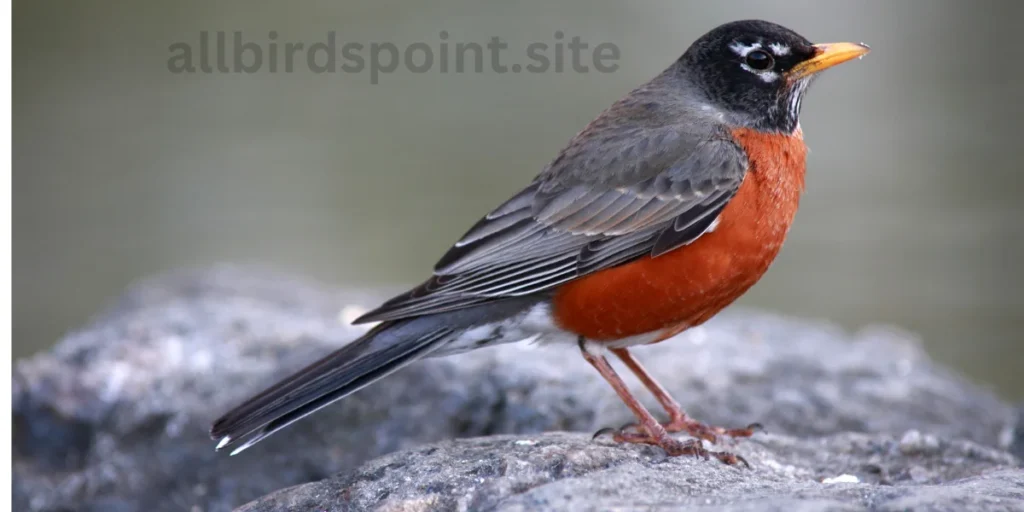
The American Robin is a beloved bird in North America, instantly recognizable by its bright red-orange chest and cheerful song. This birds is often associated with the arrival of spring, as it is one of the first to return from its winter migration.
American Robins are highly adaptable and can be found in various habitats, including woodlands, gardens, and even urban areas. They are ground feeders, frequently seen hopping around lawns and parks searching for worms and insects. Robins are known for their distinctive and melodious song, which adds a pleasant soundtrack to their surroundings. During the breeding season, they build nests in trees or shrubs, using a mix of grasses, twigs, and mud. The American Robin’s vibrant chest and melodious song make it a favorite among birdwatchers and nature enthusiasts.
| Feature | Description |
|---|---|
| Chest Color | Bright red-orange |
| Back Color | Dark gray |
| Size | Medium-sized, about 10 inches long |
| Diet | Worms, insects, fruits |
| Habitat | Forests, gardens, parks, urban areas |
| Migration | Yes, migrates between breeding and wintering grounds |
2. House Finch
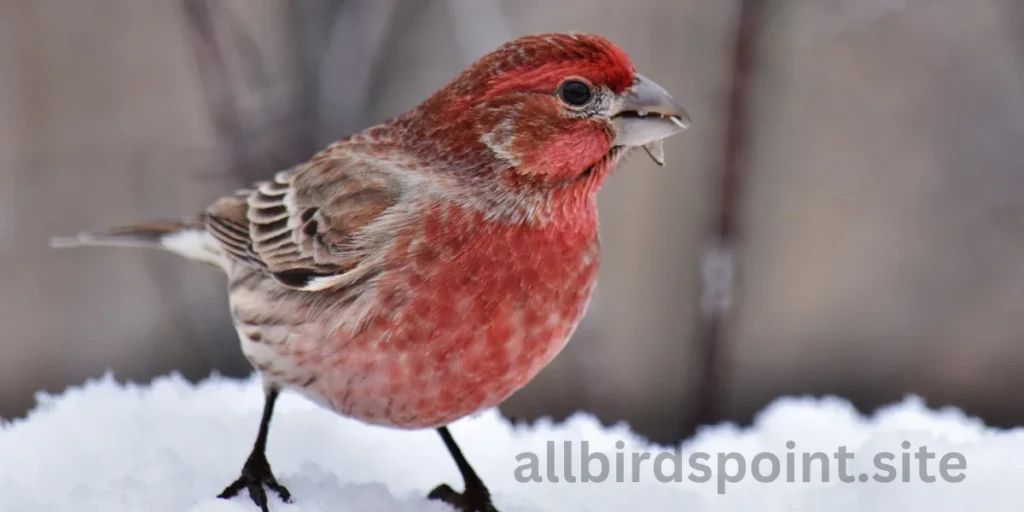
The House Finch is a small, adaptable bird that has become a common sight in urban environments across North America. Males are particularly noted for their bright red chests, which are even more vivid during the breeding season. This coloration is a result of their diet, which includes a variety of fruits and berries.
House Finches are social birds, often seen in flocks, and they are known for their cheerful, warbling songs. They are highly adaptable and can build their nests in diverse locations, from trees to ledges on buildings. Their ability to thrive in both natural and human-made environments demonstrates their remarkable adaptability. House Finches are year-round residents in many areas, making them a familiar and beloved species for birdwatchers.
| Feature | Description |
|---|---|
| Chest Color | Bright red |
| Back Color | Brown-streaked |
| Size | Small, about 5-6 inches long |
| Diet | Seeds, fruits, berries |
| Habitat | Urban areas, forests, gardens, deserts |
| Migration | Generally non-migratory, some local movements |
3. Northern Cardinal
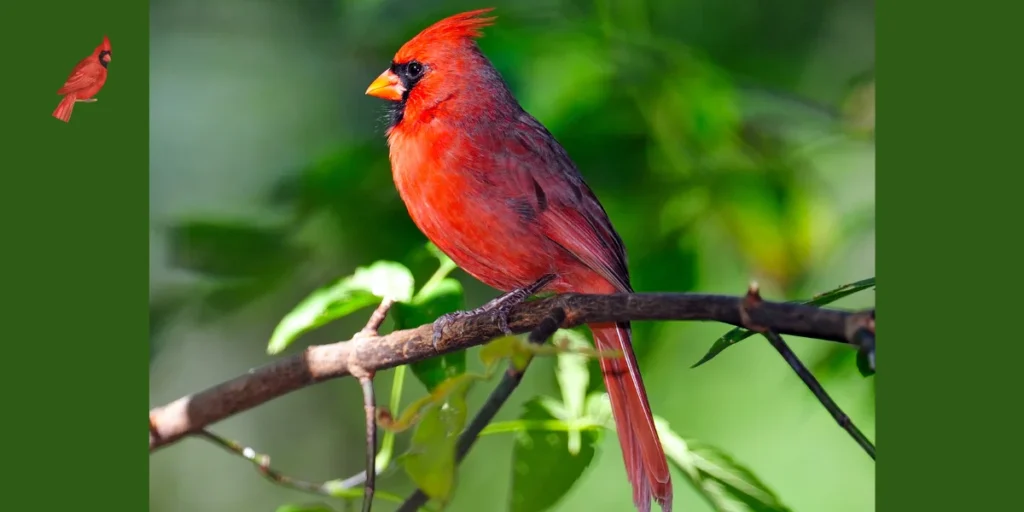
The Northern Cardinal is a stunning bird known for its vivid red chest and striking crest. Males are especially vibrant, with their bright red plumage serving both as a signal of dominance and an attraction for potential mates. Females, while less colorful, still possess a soft, warm reddish-brown hue. Northern Cardinals are not only beautiful but also have a rich vocal repertoire, including a variety of whistles and chirps. They are often found in dense, shrubby areas, where they build nests with care. These birds are non-migratory, staying within their territories year-round, which allows birdwatchers to enjoy their presence throughout all seasons. Their bold coloration and cheerful songs make them a highlight in any birdwatching experience.
| Feature | Description |
|---|---|
| Chest Color | Vivid red (male), reddish-brown (female) |
| Back Color | Red (male), brownish (female) |
| Size | Medium-sized, about 8-9 inches long |
| Diet | Seeds, fruits, insects |
| Habitat | Woodlands, gardens, wetlands, shrublands |
| Migration | Non-migratory, stays in the same area year-round |
4. Rose-breasted Grosbeak

The Rose-breasted Grosbeak is a striking bird, particularly the males, who sport a bold red chest that stands out against their black and white plumage. Their colorful appearance is complemented by a melodious song, which is often described as rich and varied. Rose-breasted Grosbeaks are found in deciduous forests and woodlands, where they forage for insects, seeds, and fruits.
They build their nests in the dense foliage of trees, making use of their vibrant colors to attract mates during the breeding season. These birds migrate between their breeding grounds in North America and their wintering habitats in Central and South America, covering significant distances each year. Their vivid coloration and beautiful songs make them a treasured sight for bird enthusiasts.
| Feature | Description |
|---|---|
| Chest Color | Bright red (male), pale red or none (female) |
| Back Color | Black and white (male), brownish (female) |
| Size | Medium-sized, about 7-8 inches long |
| Diet | Insects, seeds, fruits |
| Habitat | Deciduous forests, woodlands |
| Migration | Yes, migrates between North America and Central/South America |
5. Scarlet Tanager
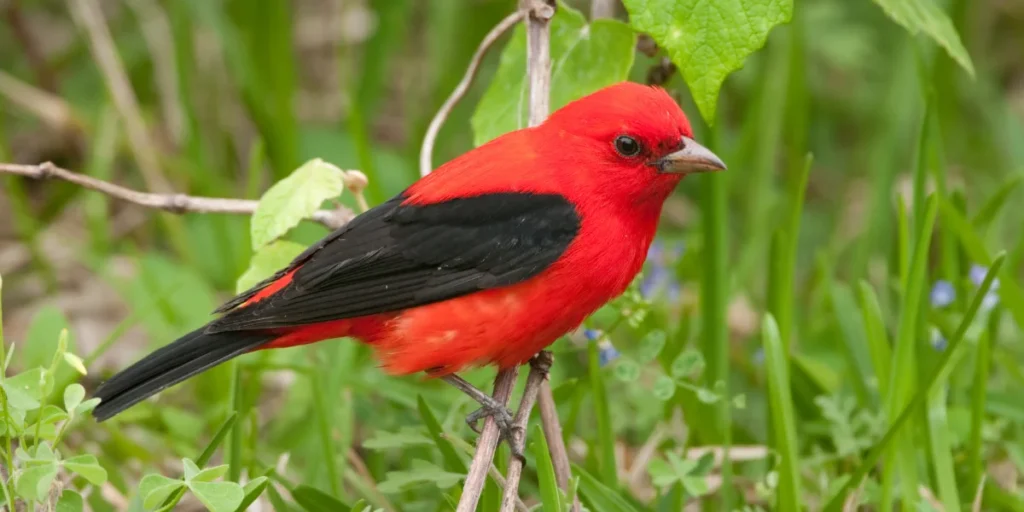
The Scarlet Tanager is one of the most visually striking birds in North America. Males are adorned with brilliant red plumage on their bodies and contrasting black wings and tails, making them highly visible in their forest habitats. Females, while less colorful, have a greenish-yellow appearance that blends well with their surroundings. Scarlet Tanagers are known for their beautiful songs, which are a combination of high-pitched notes and trills.
They prefer mature deciduous forests and are often seen flitting through the canopy in search of insects and fruits. During migration, these birds travel from their breeding grounds in North America to their wintering areas in Central and South America. Their vivid colors and melodic songs make them a favorite among birdwatchers, though they can be challenging to spot due to their high canopy habitats.
| Feature | Description |
|---|---|
| Chest Color | Bright red (male), yellow-green (female) |
| Back Color | Black (male), darker green (female) |
| Size | Medium-sized, about 7-8 inches long |
| Diet | Insects, fruits |
| Habitat | Mature deciduous forests |
| Migration | Yes, migrates between North America and South America |
6. Red-breasted Nuthatch
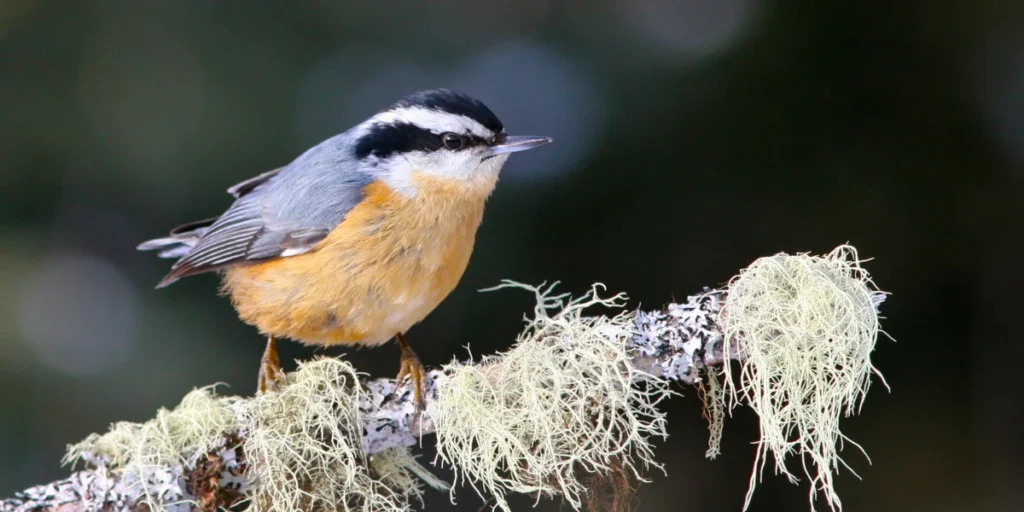
The Red-breasted Nuthatch is a small and agile bird with a distinctive reddish chest and a blue-gray back. Known for its ability to climb down trees headfirst, this bird is a frequent visitor to coniferous forests, where it searches for insects and seeds. Red-breasted Nuthatches are easily recognizable by their nasal, horn-like calls and their energetic, acrobatic behavior. They are year-round residents in many areas, but their populations can move southward in response to harsh winter conditions. Their unique climbing skills and cheerful calls make them a delightful species to observe in the forest. The combination of their colorful plumage and dynamic movements adds to their charm and makes them a favorite among birdwatchers.
| Feature | Description |
|---|---|
| Chest Color | Reddish |
| Back Color | Blue-gray |
| Size | Small, about 4-5 inches long |
| Diet | Insects, seeds |
| Habitat | Coniferous forests |
| Migration | Generally non-migratory, some southward movement in winter |
7. European Robin
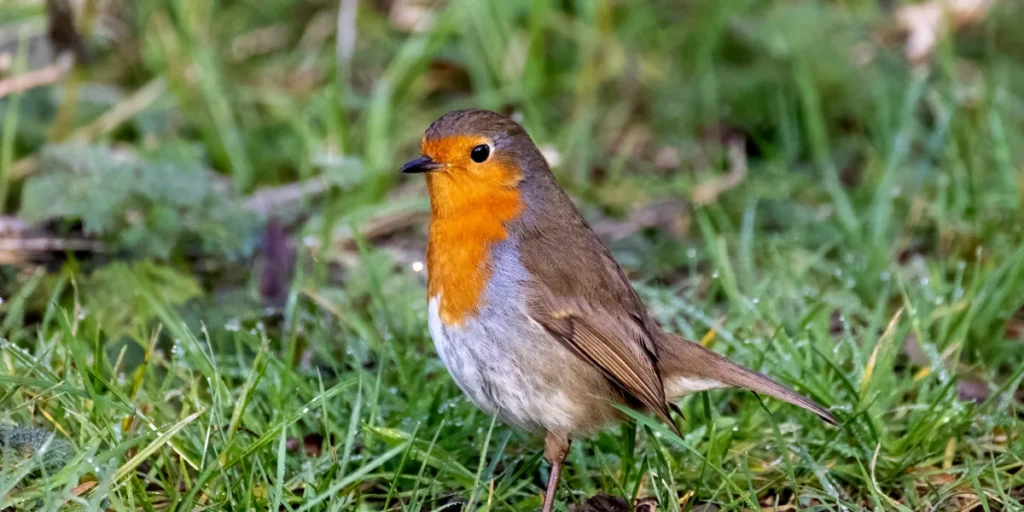
The European Robin, often referred to simply as the Robin in Europe, is a charming and friendly bird with a bright orange-red chest. It is a common sight in gardens, woodlands, and parks throughout Europe. European Robins are known for their curious and approachable nature, often coming close to humans as they forage for insects, worms, and fruits. Their melodious song is a pleasant sound in many natural settings. Unlike their American counterparts, European Robins generally do not migrate but may move locally in search of food during harsh weather. Their vibrant chest color and friendly behavior make them a beloved bird in European culture and a frequent visitor to backyard bird feeders.
| Feature | Description |
|---|---|
| Chest Color | Orange-red |
| Back Color | Brown |
| Size | Small, about 5-6 inches long |
| Diet | Insects, worms, fruits |
| Habitat | Gardens, woodlands, parks |
| Migration | Generally non-migratory, some short-distance movements |
8. Vermilion Flycatcher
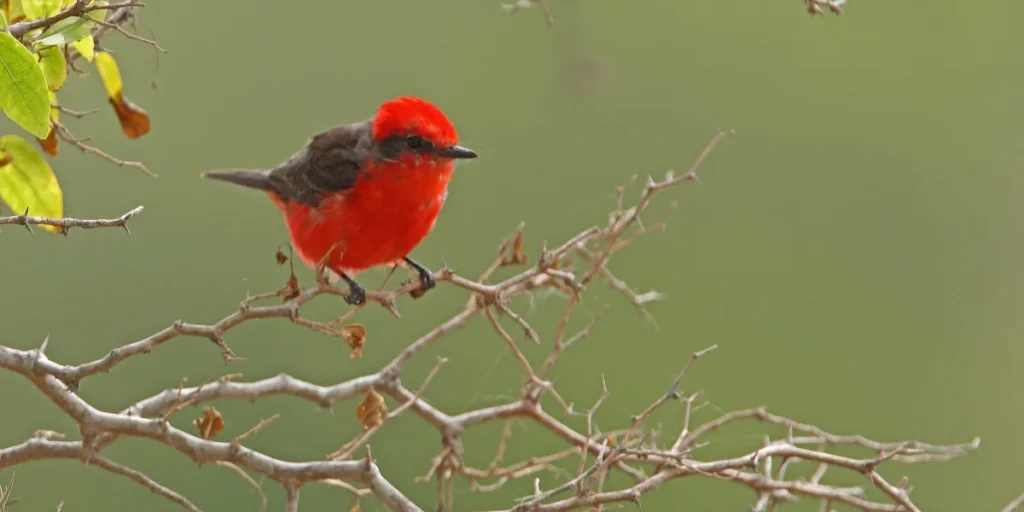
The Vermilion Flycatcher is a striking bird known for its brilliant red plumage, which is especially vivid in males.
These birds are found in arid and semi-arid regions of the southwestern United States and Mexico. They are often seen perched on low branches or fences, where they hunt for insects in mid-air. Vermilion Flycatchers are highly territorial, and their bright colors play a role in attracting mates and defending their territory. They build their nests in sheltered locations, such as in trees or shrubs, and their distinctive call and vibrant appearance make them a highlight for birdwatchers in their range. Their dazzling red coloration and active hunting behavior make them a fascinating species to observe.
| Feature | Description |
|---|---|
| Chest Color | Bright red |
| Back Color | Brownish or olive |
| Size | Small to medium-sized, about 5-6 inches long |
| Diet | Insects |
| Habitat | Arid and semi-arid regions |
| Migration | Generally non-migratory, some local movements |
9. Crimson Sunbird
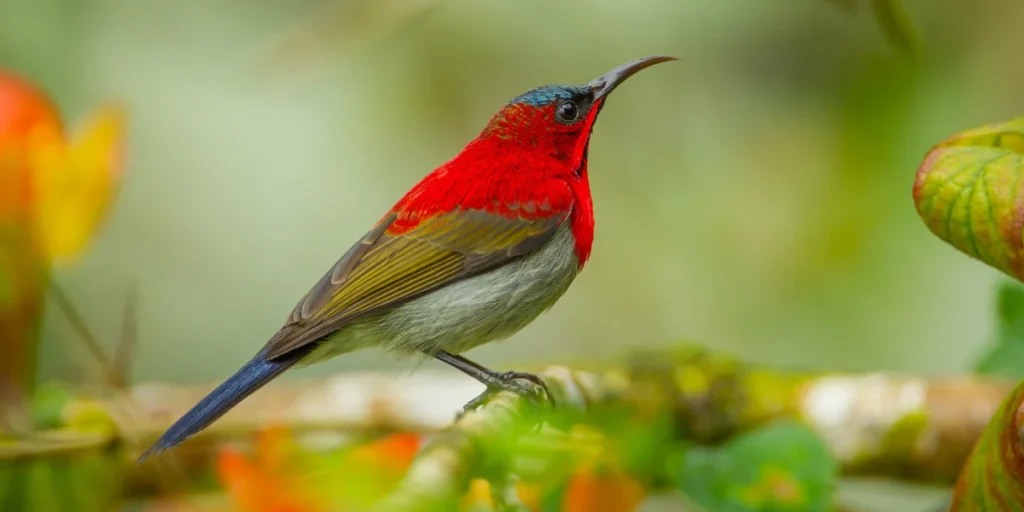
The Crimson Sunbird is a small, strikingly colorful bird found in Southeast Asia. Males are adorned with brilliant crimson plumage on their chests, contrasting with their greenish backs. These birds are often seen darting around flowers, feeding on nectar with their long, curved bills. Crimson Sunbirds are highly energetic and are known for their rapid movements and hovering flight. They play a crucial role in pollination due to their feeding habits, transferring pollen from one flower to another. Their beautiful plumage and dynamic behavior make them a favorite among birdwatchers and nature enthusiasts. Their vivid colors and active feeding habits highlight their important role in their ecosystems.
| Feature | Description |
|---|---|
| Chest Color | Crimson (male), olive-yellow (female) |
| Back Color | Green (male), olive-yellow (female) |
| Size | Small, about 4-5 inches long |
| Diet | Nectar, insects |
| Habitat | Forests, gardens, plantations |
| Migration | Generally non-migratory |
10. Red Crossbill
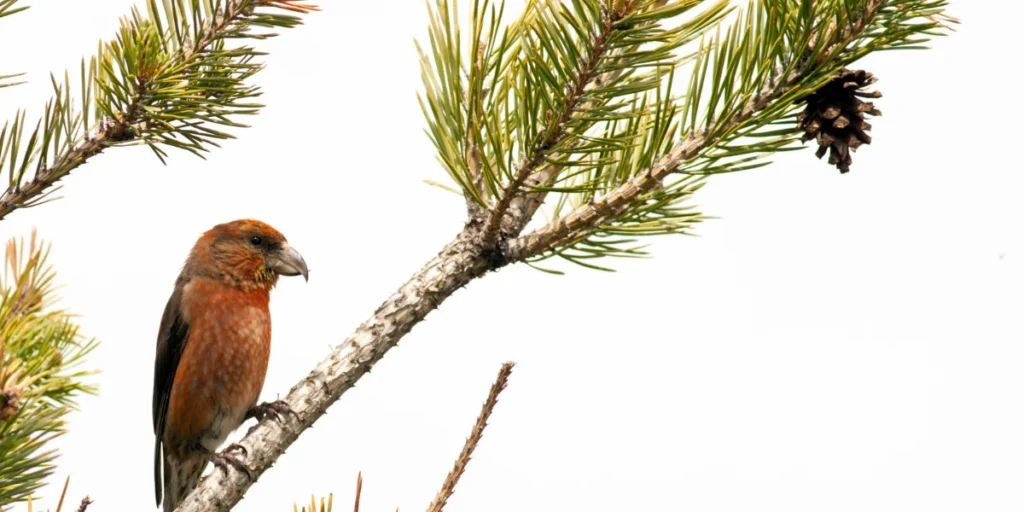
The Red Crossbill is a distinctive bird with a unique crossed bill, adapted for extracting seeds from conifer cones. Males are characterized by their reddish chest and overall red plumage, while females have a more yellowish appearance. These birds are typically found in coniferous forests, where they use their specialized bills to forage for seeds. Red Crossbills are social and often travel in flocks, making their feeding behavior a fascinating subject for study. Their breeding season is closely tied to the availability of food, allowing them to breed at various times of the year depending on conditions. The combination of their specialized feeding adaptations and vibrant plumage makes them a unique and intriguing species.
| Feature | Description |
|---|---|
| Chest Color | Reddish (male), yellowish (female) |
| Back Color | Red (male), yellowish (female) |
| Size | Medium-sized, about 6-7 inches long |
| Diet | Seeds from conifer cones |
| Habitat | Coniferous forests |
| Migration | Irregular, depending on food availability |
11. Painted Bunting
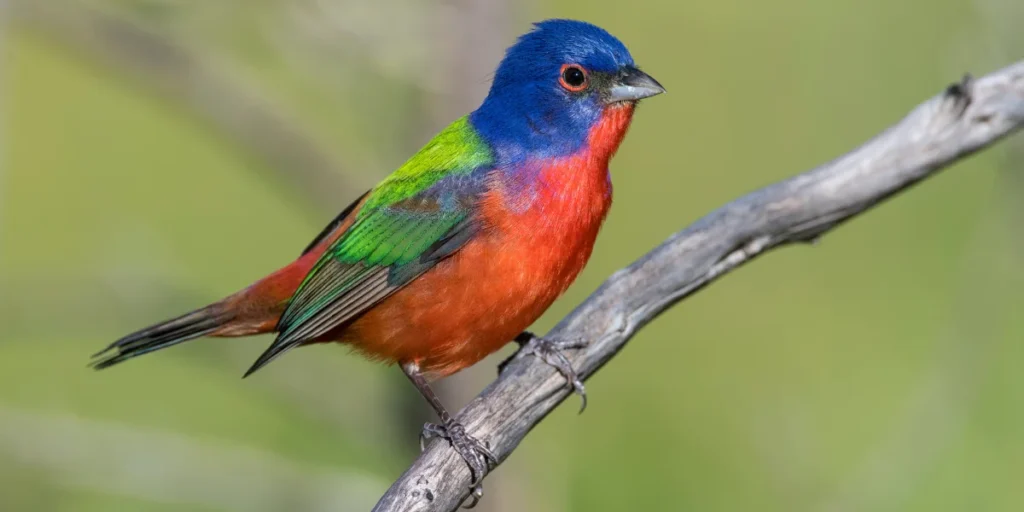
The Painted Bunting is one of the most colorful birds in North America, with males showcasing an impressive palette of bright red, blue, and green feathers. Their vivid plumage makes them a sought-after species for birdwatchers. Painted Buntings prefer dense, shrubby habitats where they can find plenty of seeds and insects to eat. They are migratory, breeding in the southern United States and wintering in Central America. The males’ brilliant colors and the females’ more subdued greenish-yellow plumage help them blend into their environments while still maintaining a striking appearance. Their vibrant colors and shy nature make them both a challenge and a delight to observe.
| Feature | Description |
|---|---|
| Chest Color | Bright red (male), greenish-yellow (female) |
| Back Color | Green (male), greenish-yellow (female) |
| Size | Small, about 5-6 inches long |
| Diet | Seeds, insects |
| Habitat | Shrubby areas, thickets, forest edges |
| Migration | Yes, migrates between the southern US and Central America |
12. Eastern Towhee
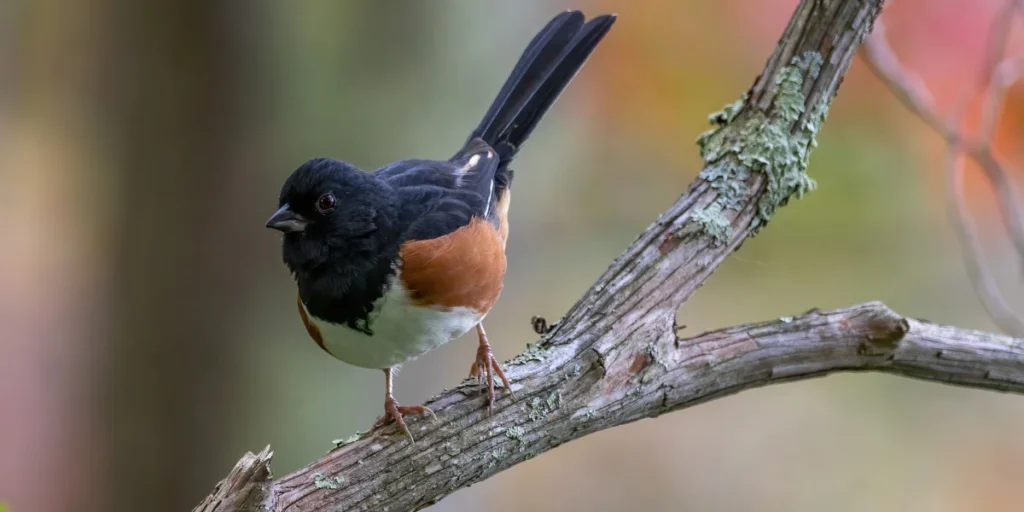
The Eastern Towhee is a striking bird with a bold black upper body, white belly, and reddish sides. Males are more vividly colored than females, but both sexes are easy to identify. Eastern Towhees are commonly found in dense underbrush and thickets, where they forage on the ground for seeds and insects. Their distinctive call, which sounds like “drink your tea,” is a recognizable feature of their vocalizations. These birds are generally non-migratory, although they may make short movements during winter in search of food. Their colorful plumage and distinctive call make them a favorite among birdwatchers who enjoy observing birds in dense, shrubby habitats.
| Feature | Description |
|---|---|
| Chest Color | Reddish sides |
| Back Color | Black (male), brownish (female) |
| Size | Medium-sized, about 7-8 inches long |
| Diet | Seeds, insects |
| Habitat | Dense underbrush, thickets, forest edges |
| Migration | Generally non-migratory, some short-distance movements |
13. Purple Finch
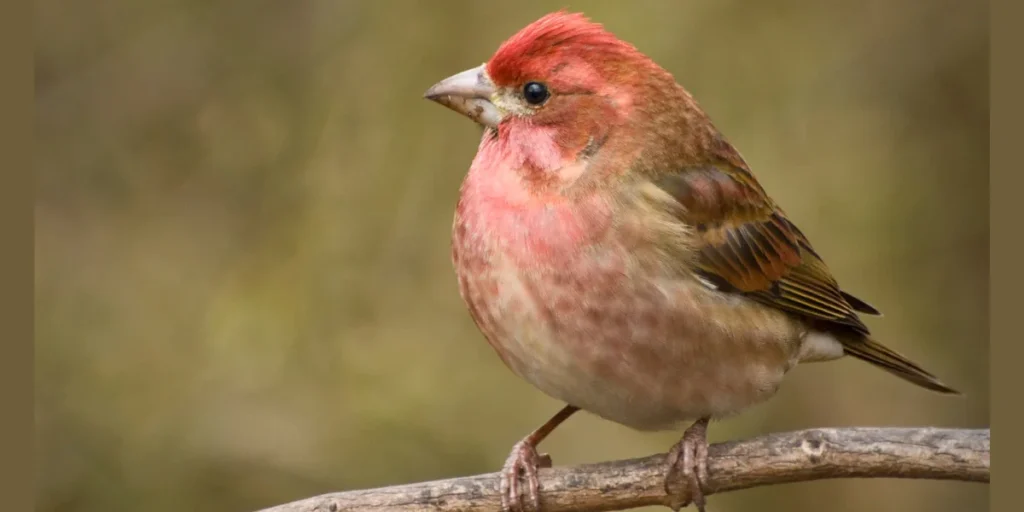
The Purple Finch is a small bird that is known for the males’ rosy-red chest and head, contrasting with their brownish backs. This bird is often heard before it is seen, thanks to its sweet, warbling song. Purple Finches inhabit forests and wooded areas, where they feed on seeds, fruits, and insects.
They are also frequent visitors to bird feeders, where their colorful plumage adds a splash of beauty. During the breeding season, Purple Finches build their nests in trees and shrubs, creating a cozy environment for their young. While some populations migrate south in the winter, others remain in their breeding areas if food is abundant. Their combination of vibrant plumage and pleasant song makes them a joy to observe.
| Feature | Description |
|---|---|
| Chest Color | Rosy-red (male), brownish (female) |
| Back Color | Brown with streaks |
| Size | Small, about 5-6 inches long |
| Diet | Seeds, fruits, insects |
| Habitat | Forests, woodlands, gardens |
| Migration | Partial migrant, some populations move southward in winter |
14. Western Tanager

The Western Tanager is a vibrant bird known for its striking yellow body and red-orange head and chest. Males are especially colorful, making them a spectacular sight in their coniferous and mixed forest habitats. Females are yellowish and less vivid but still attractive. Western Tanagers are migratory birds, breeding in North America and traveling to Central America for the winter. Their colorful plumage and melodious songs are highlights for birdwatchers, though their bright colors can sometimes make them difficult to spot amidst the dense foliage. These birds primarily feed on insects and fruits, which they find in their forest environments. Their vibrant appearance and beautiful songs make them a favorite among those who enjoy birdwatching.
| Feature | Description |
|---|---|
| Chest Color | Red-orange (male), yellowish (female) |
| Back Color | Yellow (male), yellowish (female) |
| Size | Medium-sized, about 6-7 inches long |
| Diet | Insects, fruits |
| Habitat | Coniferous and mixed forests |
| Migration | Yes, migrates between North America and Central America |
15. Spotted Towhee
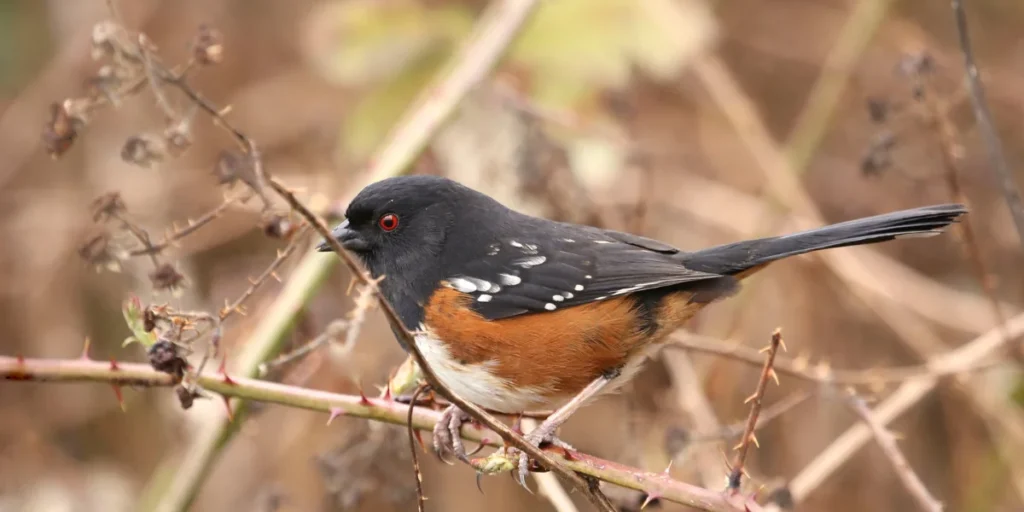
The Spotted Towhee is a visually striking bird with its black upper parts, white spots, red sides, and white belly. Males are especially colorful, making them easily recognizable, while females have a more subdued coloration but are still distinctive. Spotted Towhees are often found in dense underbrush and thickets, where they search for seeds and insects on the ground. Their distinctive call, which sounds like “drink your tea,” is a key feature of their vocalizations. These birds are generally non-migratory, though they may make short movements during winter to find food. Their bold plumage and distinctive call make them a fascinating species for birdwatchers who enjoy observing birds in dense, shrubby habitats.
| Feature | Description |
|---|---|
| Chest Color | Red sides |
| Back Color | Black with white spots (male), brownish with spots (female) |
| Size | Medium-sized, about 7-8 inches long |
| Diet | Seeds, insects |
| Habitat | Dense underbrush, thickets, forest edges |
| Migration | Generally non-migratory, some short-distance movements |
These birds with their distinctive red chests and varied characteristics, highlight the beauty and diversity of the avian world. Each species brings its own unique colors, songs, and behaviors, making them fascinating subjects for birdwatching and study.

3 thoughts on “Top 15 Birds With Red Chests (Information With Photos)”